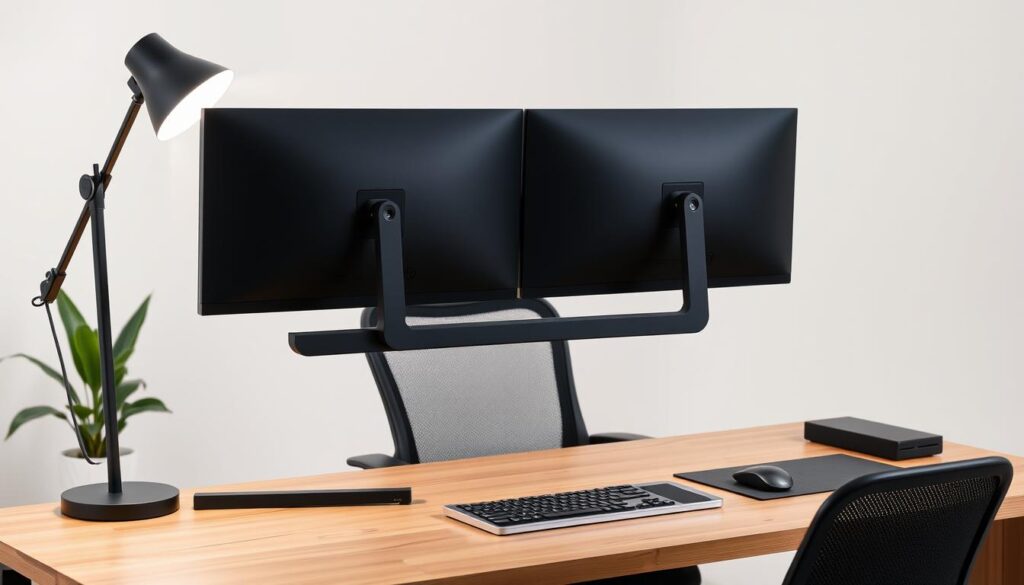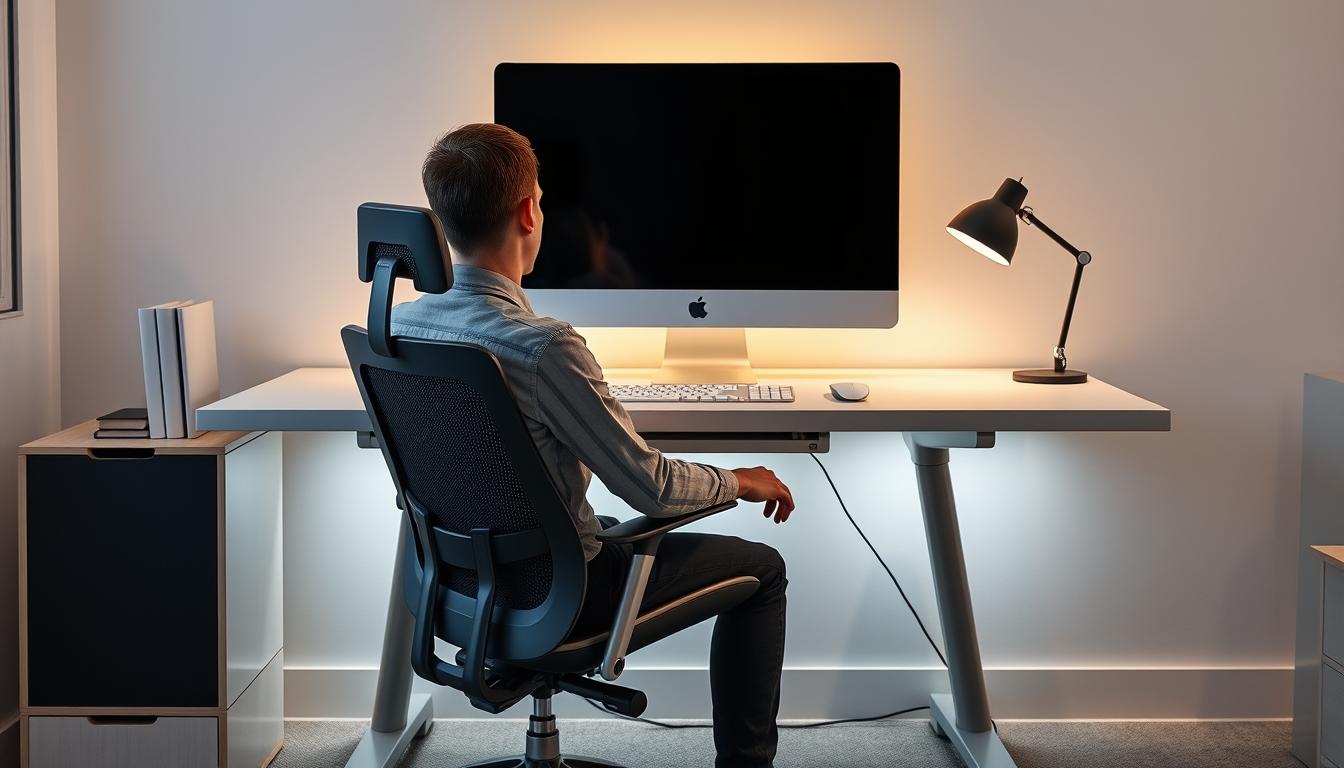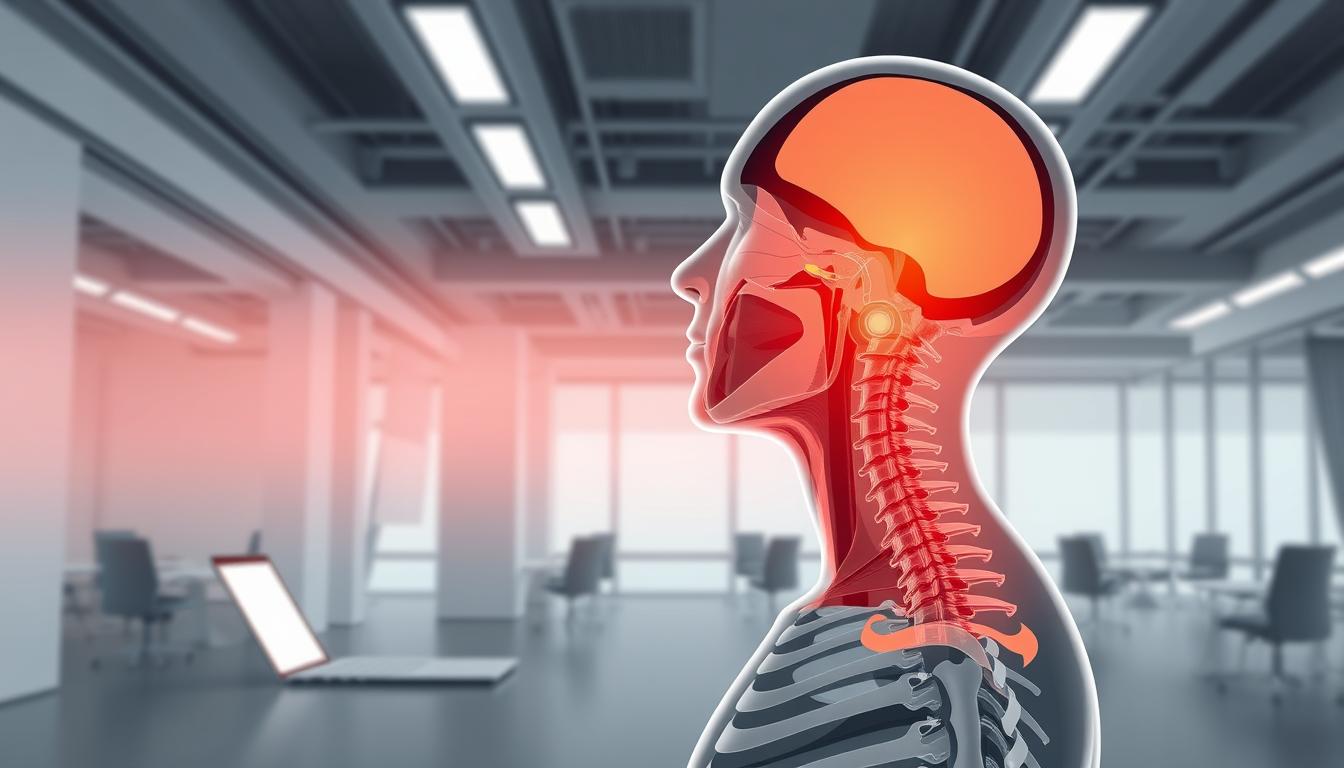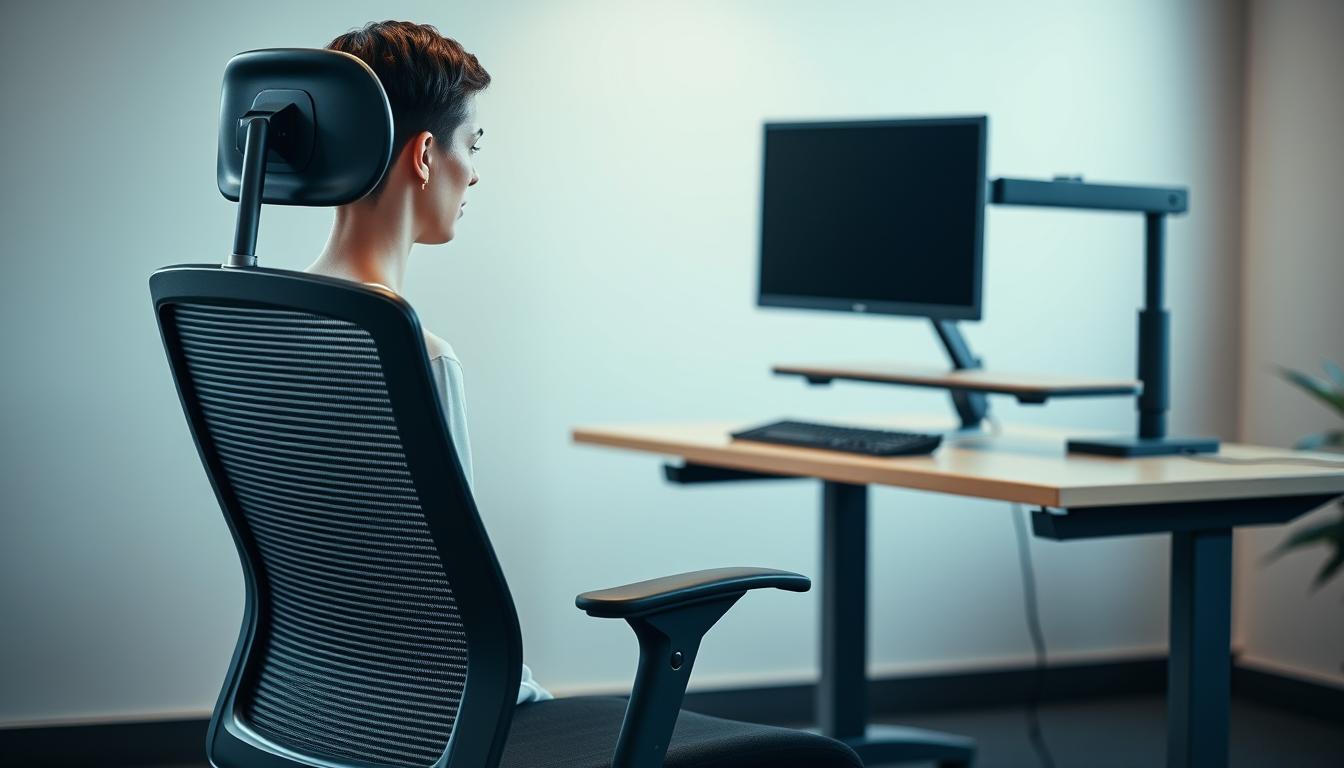In the U.S., the use of two monitors at the same time has soared by 70% since 2002. This change makes people a lot more productive. But, it can also lead to neck pain if not done right. If your screens aren’t lined up well, you might strain your neck. This hurts your health and work.
Positioning your screens correctly is key to avoiding neck issues with two monitors. Doing so can lessen neck pressure a lot. It’s important for making sure people work without discomfort. This helps workers stay healthy and companies do better.
The Rise of Dual Monitor Setups
More companies now understand the perks of having dual monitor setups. They boost work productivity. Studies show that having two screens can up productivity by 20% to 42%. This boost is seen across various jobs, helping those working from anywhere.
Dual monitors are trending, especially with more remote work. These setups make juggling tasks easier and improve how work flows. They let workers look at documents side-by-side, keep an eye on data, and chat without a fuss. It makes staying organized simpler, too.
Using dual monitors is great, but setting them up right is key. Adjusting their position and height helps avoid strain. It makes working long hours healthier and more comfortable.
Benefits of Using Dual Monitors
Having two monitors really helps, especially at work. You can look at different documents or apps without swapping tabs. This makes doing many things at once much easier and more organized.
Studies show that using two monitors can make you more productive. It’s easier to see and reach everything you need. This ease means less brain strain when moving between apps, making work flow better and quicker.
Common Neck Pain Issues in Dual Monitor Usage
Many people who use two monitors often have neck pain. This happens because of where the monitors are placed and bad posture. The main cause of neck pain is moving your neck too much to see both screens. This can make your neck hurt and feel tired after a while, which experts call “Dual & Large Monitor Neck Syndrome.”
Another problem is having a messy desk setup. Sometimes, monitors are set up so you have to strain your neck to see. If things are not arranged the right way, it can make your neck feel even worse. This is known as ergonomics neck strain.
It’s important to know about these risks to your health. Doing something about it early can stop the pain from working on computers too long. Make sure to adjust the height and position of your monitors to keep your neck healthy.
How to Set Up Dual Monitors Without Neck Pain
Setting up two monitors needs careful planning for comfort and efficiency. The right monitor height and placement are key for a great workspace. These steps help lower neck and eye strain and boost your work output.
Understanding Ideal Monitor Position
For two monitors, each should line up with your sight. They should be at the same height and size, and an arm’s length away. This helps reduce strain and makes viewing comfortable. The screen tops should be eye-level to keep your head straight and avoid awkward angles.
Setting the Right Monitor Height
Getting your monitor height right is crucial for being comfortable. Your eyes should meet the top third of the screen. Use stands or adjustable arms to get this height right. This way, you’ll look at the screen naturally and avoid neck pain from long periods of use.
Creatively Positioning Monitors for Optimal Viewing
In a two-monitor setup, how you position them is important. Put your main monitor in front and the second one slightly to the side you prefer. This setup reduces the need to turn your neck and makes using both screens easier. With these tips, you’ll have a workspace that’s good for staying productive without hurting your comfort.
The Importance of Posture in a Dual Monitor Setup
Having the right posture with two monitors is key for comfort and work output over time. Sitting properly helps avoid pain and lowers the risk of getting hurt, especially when using the screen a lot. To sit right, make sure your chair supports your lower back and keeps your spine straight.
Your feet should be flat on the floor, and your legs should be level with it. This helps keep you stable and takes stress off your spine. When typing, keep your arms level with the desk. This lets you move easily without hurting your shoulders or neck. If your workspace isn’t set up right, you could end up with a lot of neck pain.
To wrap up, being aware of your posture with two screens can make a big difference in how comfortable you are. Choosing the right chair and keeping a good posture helps with your health and how well you do your tasks.
Ergonomic Desk Accessories for Comfort
Adding ergonomic desk accessories greatly improves how comfy and efficient a dual monitor setup can be. By adjusting your setup with the right accessories, you get better viewing angles. This lessens strain and makes work more enjoyable.
Monitor Arms and Stands
Monitor arms make it easy to move your screens exactly where you need them. These arms let you change both the height and tilt of your monitors with ease. This helps you sit better and reduces neck pain. When you use two monitors, getting them at the right eye level is key.
Keyboard and Mouse Positioning
How you place your keyboard and mouse really matters for staying comfortable while you work. Keeping the keyboard at the right height helps avoid wrist pain. The mouse should be close to avoid having to reach for it. This lets you work without discomfort and enjoy your time at the desk more.

Regular Breaks and Eye Care Techniques
It’s key to take regular breaks to keep your eyes and body happy during long computer sessions. Using strategies like the 20-20-20 rule and short breaks can really help with eye strain and neck pain.
The 20-20-20 Rule Explained
The 20-20-20 rule is a great way to care for your eyes. Every 20 minutes, take a moment to look at something 20 feet away for 20 seconds. This helps your eyes relax and cuts down on tiredness from looking at screens.
Micro-breaks for Neck Relief
Taking short breaks regularly can make you more comfortable and ease neck and shoulder tension. These quick pauses let you stretch and move around, which helps prevent discomfort from sitting too long. Remembering to take these short breaks makes for a healthier workday.
Creating a Comprehensive Ergonomic Workspace
Creating a comfy and productive space starts with knowing how to design it ergonomically. The right chair setting and right office lighting are key to making a good environment. They help keep discomfort away while working long hours in front of two screens.
Adjusting Your Chair for Optimal Support
To keep your spine happy, getting your chair setting right is key. Here’s how to make sure your chair supports you well:
- Adjust the height so your feet rest flat on the ground.
- Keep your knees at or slightly below hip level.
- Ensure the backrest supports the natural curve of your spine.
- Reclining slightly can reduce strain on your lower back.
Lighting Considerations to Reduce Strain
Good lighting can really help your eyes and keep you focused. Consider these tips when setting up your workspace:
- Position your desk to avoid glare from windows and overhead lights.
- Utilize ambient lighting that evenly illuminates the space without harsh contrasts.
- Use task lighting for focused work, ensuring it complements the main light source.
- Adjust blinds or curtains to control natural light entering the room, avoiding direct exposure.
Conclusion
Setting up two monitors in the right way is key to avoiding neck pain. It also helps make your workspace more productive. Putting monitors at the correct angle and keeping good posture are important. Accessories that support ergonomics make this setup even better.
Taking breaks often and designing a good workspace are also crucial for a healthy work life. These steps make using two monitors even more beneficial. They help with getting more done and staying healthy in the long run.
When companies focus on ergonomics, they see big improvements in how well employees work and their health. As dual monitors become more common, knowing how to use them right is essential. This ensures a workspace that is not only efficient but also comfortable.



